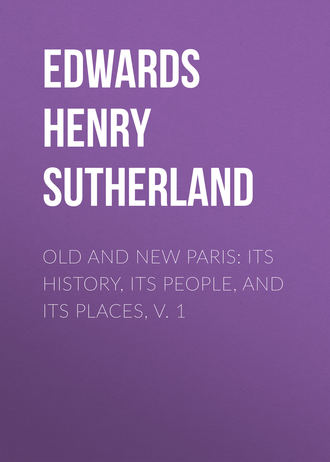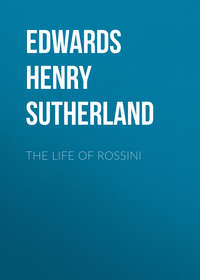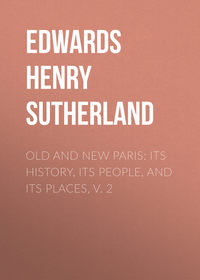 полная версия
полная версияOld and New Paris: Its History, Its People, and Its Places, v. 1
The last King of France and of Navarre died on the 6th of July, 1836, and it was not until nine days afterwards that the fact was made known to the French public through the columns of the Gazette de France. The heart of Charles X. was, according to royal custom, separated from the body; though, instead of being preserved apart, as in the case of former French kings, it was enclosed in a box of enamel, and fastened with screws to the top of the coffin. The Comte de Chambord, on the other hand, was buried in the ordinary manner, and not, like Charles X., with his heart on the coffin lid; nor, like Louis XVIII., with his heart in one place and his body in another. The dead, according to the German ballad, “ride fast.” But the living move still faster; and in France, almost as much as in England, the separation of a heart from the body, to be kept permanently as a relic, is in the present day a process which seems to savour of ancient times, though, as a matter of fact, it was common enough among the French at the end of the last century. In our own country the discontinuance of what was at one time as much a custom in England as in France, or any other continental land, is probably due to the influence of the Reformation, which, condemning absolutely the adoration of the relics of saints, did not favour the respectful preservation of relics of any kind. Great was the astonishment caused in England when in the last generation it was found that Daniel O’Connell had by will ordered his heart to be sent to Rome. The injunction was made at the time the subject of an epigram, intended to be offensive, but which would probably have been regarded by O’Connell himself as flattering: setting forth, as it did, that the heart which was to be forwarded to Rome had never in fact been anywhere else. The reasons for which in the Middle Ages hearts were enclosed in precious urns may have been very practical. Sometimes the owner of the heart had died far from home, and in accordance with his last wishes, the organ associated with all his noblest emotions was sent across the seas to his living friends. Such may well have been the case when, after the death of St. Louis at Tunis, the heart of the pious king was transmitted to France, where it was preserved for centuries – perhaps even until our own time – in La Sainte Chapelle. In the year 1798, while some masons were engaged in repairing the building which had been converted into a depôt for State archives, they came across a heart-shaped casket in lead, containing what was described as “the remains of a human heart.” The custodians of the archives drew up a formal report on the discovery, and enclosing it in the casket with the relics, replaced the casket beneath the flagstones whence it had been disinterred. In 1843, when the chapel was restored, the leaden heart-shaped receptacle was found anew, and a commission was appointed to decide as to the genuineness of the remains, believed to be those of St. Louis. An adverse decision was pronounced, the reasons for discrediting the legend on the subject being fully set forth by M. Letrenne, the secretary of the commission.
The Boulevard Bonne-Nouvelle, which comes next to the Boulevard Saint-Denis, is bounded on the right by the Faubourg Poissonnière, and on the left by the Butte aux Gravois, on which was built in the seventeenth century the quarter named, after its parochial church, Notre-Dame de Bonne Nouvelle. The Bonne Nouvelle Bazaar, constructed in the reign of Louis Philippe, contained, in the basement, a sort of theatre of considerable size, where, in 1848, several political clubs and other conventions were established. Here on one particular day, arriving together by opposite staircases, Victor Hugo and Frédéric Lemaître would present themselves at the speaker’s desk erected for political orators. Ultimately, but not without some hesitation, the interpreter of Ruy Blas gave way to the creator of the part. The object of the assembly was to constitute in a permanent way a club for Parisian writers and artists of the dramatic and other schools. Close by, at No. 26, is the Viennese beer-house, established on the site of the theatre opened in 1838, where the company of the old Vaudeville Theatre took refuge when, on the 18th of July in that year, they were burnt out.
There is now but one theatre on the Boulevard Bonne-Nouvelle – that of the Gymnase, opened on the 20th of December, 1820, under the patronage of the Duchess of Berri, who four years afterwards allowed it to take the title of “Théâtre de Madame,” which it retained until the Revolution of 1830. It was then entitled the “Gymnase Théâtre Dramatique,” afterwards to be known simply as the Gymnase. For the last seventy years the Gymnase has been one of the very best theatres of the second order, ranking immediately after the theatres subventioned by the State. It was at the Gymnase that Scribe made his brilliant reputation with a long succession of little masterpieces, until at length he was followed by Alexandre Dumas the younger, who here produced “Le Demi-Monde,” “Diane de Lys,” and many other pieces less imposing, perhaps, but more thoughtful and more powerfully written than those of his predecessor. It was at the Gymnase, too, that Sardou brought out many of his best pieces, such as “Les Ganaches,” “La Perle noire,” “Nos bons Villageois,” and “Fernande.” This theatre, moreover, was the birthplace of Meilhac and Halévy’s “Frou-Frou.”
The first house on the Boulevard Poissonnière, at the corner of the street of that name, bears an inscription which fixes at this point the boundary of Paris in 1726, though by some authorities 1726 is said to have been substituted for the true year in which the boundaries of Paris were marked – namely, 1702.
With the last house on the Boulevard Poissonnière, at the corner of the Faubourg Montmartre, begins a whole series of celebrated restaurants. As the origin of this familiar word is not universally known, it may here be mentioned that it originated with an eating-house keeper, who inscribed above his establishment in large letters the following passage from the Gospel: “Venite ad me et ego ‘Restorabo’ vos.” This restaurateur, or restaurant-keeper, had imitators, and the name which his quotation had suggested was applied to all of them. Paul Brébant, known as the restaurateur des lettres, has fed more than one generation of authors and journalists, who have not neglected him on becoming senators or ministers. A great number of monthly entertainments are given at this restaurant. Here dine together the Society of Men of Letters, the Dramatic Critics’ Club, the Parisians, the Spartans, etc. Passing on, we next reach the ancient café of the Porte Montmartre, installed in the house which once belonged to the Marchioness de Genlis, sister-in-law of the authoress who superintended the education of the Orleans princes.
Close by is the bazaar or arcade known as the Passage des Panoramas, which owes its name to a series of panoramas representing Paris, Lyons, London, and Naples, established here, under special privilege, by Robert Fulton, the inventor of steamers. The money which he made by exhibiting the panoramas enabled him to continue his experiments in marine locomotion. To the left of the Passage des Panoramas was a strip of land, on which, in 1806, the Théâtre des Variétés was built. This little theatre, which, under the name of Variétés Montansier, occupied the site where now stands the Théâtre du Palais Royal, had committed the offence of attracting the public and filling its coffers with gold, while the Comédie Française, close to it, had scarcely been able to make both ends meet. The famous theatre where, at that time, the principal actor was Talma and the principal actress Mlle. Mars, uttered a formal complaint; and the liberty of the stage being then at an end, the Théâtre des Variétés was expelled from the Palais Royal, but allowed to take refuge in a new house built especially for it on the before-mentioned strip of land.
For many years the Théâtre des Variétés undertook to amuse the public with the lightest comedies, in which such actors as Brunet, Potier, Vernet, and Odry, such actresses as Flore and Jenny Vertpré appeared. After the Revolution of July, 1830, it made experiments in a more serious style, producing, for instance, the “Kean” of Dumas the elder, with Frédéric Lemaître in the principal character, and Bressant in the part of the Prince of Wales. Under the Second Empire the Variétés returned to its old trade, besides adopting an entirely new one – that of opera-bouffe, as cultivated by Offenbach. Here the earliest and best works of this master, such as “La belle Hélène” and the “Grand Duchess of Gerolstein,” were first performed, with Schneider and Dupuis in the principal parts. Here, too, some of the best comedies of Meilhac, Halévy, and Labiche were brought out.
The Boulevard Montmartre, in front of the Variétés, is the most animated part of the whole line of boulevards. The late Henri Dupin, the famous boulevardier, who died a centenarian, used to pretend that he had shot rabbits between the Rue Montmartre and the adjoining Rue Richelieu. This was doubtless an exaggeration. But a representation of this part of Paris, painted in the days of the First Empire, shows that at the point in question there were ditches intersecting a road lined with trees. The Boulevard Montmartre combines some of the features of the upper and of the lower boulevard, the shops which here abound offering for sale objects of use and of ornament, of interest and of luxury: clothes, bonnets, books, chocolate, bonbons, and music.
At the corner of the Boulevard Montmartre and the Rue Vivienne stood the famous public gambling-house of Frascati, where, until the reign of Louis Philippe, as at a similar establishment in the Palais Royal, games of hazard were publicly played. These gambling-houses bore an important, and often, no doubt, disastrous part in the social life of the French capital, and innumerable anecdotes have been told of the sums lost and won within their walls.
Both comedy and tragedy bore a part in the scenes produced by the fascinating cards. Materials for a farce might be found in one scene, in which Mlle. Contat, the famous actress, figured. She was far too beautiful to want, even from her girlhood, a host of admirers. Her first love affair was sufficiently unfortunate. The successful suitor was a certain M. de Lubsac, an officer in the king’s household. He was a man of inferior birth, with an empty purse; but he was as handsome as Apollo, and a wit into the bargain. He laid such persistent siege to the actress that she at length yielded in sheer weakness to his importunity. De Lubsac was distinguished by two vices: he loved wine and cards. His passion for play was so reckless that one night he staked his beautiful mistress, or at least put to hazard the whole of her diamonds and trinkets. He lost; and the next day, just as Mlle. Contat was about to attend a fête, she looked for her jewellery in vain. The caskets were all empty; a clean sweep had been made of everything. She set up a cry of “Thieves!” and called in the police. De Lubsac thought it discreet to silence her by a free confession of his “fault.” He admitted that he had pledged the whole of the missing property. She was furious, and De Lubsac expressed the deepest contrition. “Ah!” he cried, wringing his hands, “if I only had a few louis at this moment I could repair everything!” “How?” cried Mlle. Contat, with a sudden gleam of hope. “Why, to-night,” replied Lubsac, “I feel that my luck is in. I should win everything back. But I have not a solitary sou.” The repentance of the criminal was so comic that it touched the actress’s heart. Presently she smiled, then she laughed outright. In the end she lent the gambler a couple of louis, the last she had in the world, and he hurried off to the gaming-table. In less than an hour he returned triumphant. He had won. He brought back the whole of the jewellery, which he had taken out of pawn, and he had a few louis in his pocket besides. It was impossible to be too severe with such a man. The actress, however, could not put up with him many months. He at length proved such a desperate rake that she dismissed him in disgust.
Every reader of Balzac’s invaluable novels will remember one or more scenes in which some public gambling establishment is introduced. At the Frascati people lost their money according to rule, and under the superintendence of the police. Nor did the spendthrifts who haunted it cease to play even when ruin began to stare them in the face, for an occasional piece of luck would always revive the delusion that one day the goddess Fortune would return them the sums they had squandered in wooing her. Attached to the Frascati gambling-house were illuminated gardens, imitated from those of the Italian Ridotto, and largely resorted to, under the Directory and the Consulate, by fashionable citizens. The original proprietor of the Frascati establishment, Garchi by name, died insolvent. The place was seized, and in 1799 passed into the hands of one Perrin, whom Fouché, the celebrated minister of police, appointed Farmer-General of Games. Public gambling-houses were kept up in Paris until the year 1836, when, under Louis Philippe, the “Citizen King,” they were brought to an end.
With the Frascati Gardens disappeared the charming villa built by Brongniart, with its Italian roof, its portico, and its statues. It was replaced by a house which was to enjoy a celebrity of its own. On the ground-floor it was occupied by Jannisset, the fashionable jeweller; on the first floor by Buisson the tailor, who had the honour of dressing Balzac, the greatest novelist that France, if not the world, has produced. Balzac had inspired the man with the same sort of admiration that a certain wine-merchant felt for the unfortunate Haydon. “Ought a man who can paint like that to be in want of a glass of sherry?” said Haydon to the art loving vintner who had come to ask for a settlement of his bill. “Indeed, no,” replied the wine-merchant, who not only went away without asking even for a trifle on account, but hastened to forward several dozen of sherry for Haydon’s encouragement and stimulation.
Buisson was treated by Balzac on the most friendly footing. Not only did the great novelist allow the fashionable tailor to dress him for nothing, but he also paid him long visits, and used a special set of apartments assigned to him in a lofty region of Buisson’s house, where in the midst of the workshops he was beyond the reach of troublesome creditors. Far from being ungrateful to his benefactor, Balzac has rendered him immortal by naming him again and again in his works. Buisson will, thanks to Honoré de Balzac, be always known as the fashionable tailor of Louis Philippe’s reign.
The name of Frascati at one time belonged to the present Boulevard Montmartre. It is still retained by the pastrycook who sells ices and tarts in his shop at the corner of the boulevard. It should be mentioned that this pastrycook’s shop was preceded by the Café Frascati, which owed its success entirely to the beauty of the lady who presided at the counter. When the dame du comptoir disappeared the café became deserted, and had to close its doors.
CHAPTER X
BOULEVARD AND OTHER CAFÉS
The Café Littéraire – Café Procope – Café Foy – Bohemian Cafés – Café Momus – The Death of Molière – New Year’s Gifts.
THE history of France is in a large degree the history of its cafés; and the French might well retort that the history of England is to be read in its tavern signs. On the connection between our tavern signs and our naval and military heroes it would be superfluous to insist. We have, it is true, our Dogs and Ducks, our Geese and Gridirons, our Bells and Horns, but we have also our Admiral Keppels, our Wellington Arms, our Napier’s Heads; and taking them altogether, the names of our hostelries indicate the various epochs of their origin in a remarkable manner. Another characteristic of the British tavern sign as compared with the French enseigne, whether of the café, the restaurant, or the tobacco-shop, is the permanency of the former. Who ever heard of the “Earl of Chatham” being converted into the “Sir Robert Peel,” or of “Lord Nelson” turning into “Sir Charles Napier”? Just the contrary takes place in France, where all the cafés, tobacco-shops, theatres, steamers, and even omnibuses that rejoice in what may be called representative titles, change their signs and their appellations with each successive dynasty.
But it is above all in the cafés proper that the history of France is to be read; and not the political history alone, for it can be shown that they also reflect every social, literary, and commercial change that takes place in the French metropolis. The demoiselle du comptoir in the more popular quarters of Paris is herself an important historical figure, appearing as she did during the African war as an Algérienne, in the days of the Second Republic as a priestess of Liberty, and during the siege of Sebastopol as a Tartar girl of the Crimea. But she is a political rather than a social index. Such also were the United Cooks, whose miserable gargotes flourished during the Liberty, Equality, and Fraternity period, with their bœuf à la République, their agneau à la Robespierre, their veau à la baïonnette, and their mouton à la sauce rouge. It would be difficult to say which of these was the most economical, or, above all, the most indigestible.
Far different were the restaurants and cafés whose titles and interior arrangements might be looked upon as indicative of the social and intellectual movement of the nation. Of these, the most remarkable have, at various periods, been the huge Literary Café on the Boulevard Bonne-Nouvelle, the Electric Cafés – of which there were at one time several – between the Porte Saint-Martin and the Théâtre Lyrique, and the Café Oriental, near the Boulevard du Temple. Most provincial Frenchmen and foreigners who have visited Paris in the character of sight-seers have been conducted to the dreary Café des Aveugles, and probably to the absurd Café des Singes; but it is only those who have wandered idly about the boulevards, careless how they might be devoured, that can have found their way to the Literary, the Electric, or the Oriental Café.
The Café Littéraire (to go back to some ancient notes made on the subject by the present writer) “was a building of which it would be little to say that it was more magnificent than an English palace. Above the portico the title of the establishment, in gigantic letters and in striking relief, was conspicuous. The stone staircase which led to the entrance was so imposing that as you ascended it you instinctively put your hand in your pocket to assure yourself that you had a respectable number of francs at your disposal. In the vestibule stood two officials; one the under-waiter, the other the sub-editor of the establishment. ‘Does monsieur wish to eat?’ ‘Does monsieur wish to read?’ said the two functionaries at the same moment. Anxious to offend neither, and not possessing the art of eating and reading simultaneously, we replied that we wished to play billiards. ‘You will find the professor and tables in abundance on the first floor,’ said the under-waiter. ‘Allow me to present you with the carte of my department;’ and he handed me an ordinary carte du jour. ‘Here is the carte of the department with which I have the honour to be connected,’ said the sub-editor, giving me at the same time an astounding unheard-of literary bill of fare, with poetic dishes by Lamartine and Victor Hugo, and prose entrées by the elder Dumas, Soulié, and George Sand. At the foot of the menu were printed the following General Rules: – Every customer spending a franc in this establishment is entitled to one volume of any work, to be selected at will from our vast collection; or in that proportion up to the largest sum he may expend. N.B. – To avoid delay, gentleman consumers who may require an entire romance are requested to name their author with the soup.’ After dining we repaired to the billiard-room and played a couple of games, for which two francs and a half were charged. Having paid the debt, and received a voucher for the sum, we were waited on by the editor-in-chief. In strict justice, the voucher entitled us to two volumes and a half, but the editor assured us that it was contrary to the rules of the establishment to serve less than an entire livraison. To ask for half a livraison, he said, was like ordering half a mutton-chop or half a lemonade.”
The establishment of the Café Littéraire was contemporaneous with the first issue, on a large scale, of three-franc volumes and four-sou livraisons, with liberty of the Press, open discussion, and the ascendency of literary men in connection with politics. As a natural consequence of this general intellectual activity, a taste for popular science arose, which the astronomer on the Pont-Neuf, with his long telescope and his interminable orations, was unable to satisfy.
The electric cafés instituted at this period were sufficiently curious establishments. A thirsty Parisian entering one of them for the first time in his life, found himself in a place which resembled a buffet more than a café, and in which the most remarkable object was an enormous metal counter. Having swallowed his beverage, he proceeded to place his piece of money on the counter, when, to his astonishment, he received a violent shock in the right arm, which probably caused him to drop the coin as if it were red-hot. “I have had an electric shock!” he would exclaim to some frequenter lounging near him. “Impossible!” would be the reply. “You must have knocked your funny-bone against the edge of the counter.” Protesting that he had received a galvanic shock, the victim was assured by the lounger, who had been lying in wait for his joke, that he had simply been electrified by the charms of the young lady behind the counter, just as a theatrical audience is said to be electrified by an actress or prima donna. Again, however, on receiving his change the new customer experienced a sharp shock, being the more astonished inasmuch as the habitués present put down and took up their money evidently without feeling the electric current. Then he went away mystified, to return, perhaps, later in the evening with an inexperienced friend, whom, partly from curiosity, partly in a spirit of mischief, he led up to the counter. His friend no sooner touched it than he started back electrified, but he himself found that he could this time touch it with impunity. He had now obviously been admitted amongst the initiated; and when he had gone on drinking and spending enough to entitle him to confidence, the beautiful demoiselle du comptoir condescended to explain to him the entire mystery. At the foot of the metal counter was a piece of strip iron connected with one of the wires of a galvanic battery, the other wire communicating with the counter itself. When any of the initiated touched the counter the presiding goddess stopped the current, which only novices were intended to feel. The whole device was simply employed to amuse customers. The electric counters became very popular, and had rapidly spread all over Paris, when the Government, thinking probably that such practical jokes might sometimes be carried too far, absolutely suppressed the cafés électriques.
A whole chapter might be devoted to the literary cafés of Paris, much more numerous than ever were the literary coffee-houses of London in the last century. The first Paris café destined to identify itself with literature was the Café Procope, so called from the name of its founder, Procopio Cultelli, who, in the earliest days of coffee-drinking among the French and among Europeans generally, installed himself at No. 13, Rue des Fossés-Saint-Germain, opposite the Comédie Française. The wily Sicilian had evidently opened his coffee-house in view of the French actors. But it was the authors who became its principal frequenters; first the dramatists connected with the Comédie Française, and afterwards authors of all kinds. In France, however, there are scarcely any authors who do not at least try their hand at dramatic writing. Neither Crébillon, with his Catalina, nor Jean-Baptiste Rousseau, with Jason, nor Piron, with Fernand Cortez, nor Diderot, with Le Fils naturel, nor Voltaire, with so many celebrated plays, can be regarded solely or specially as dramatists; yet all of them contributed to the French theatre, and all are remembered among the frequenters of the Café Procope.







